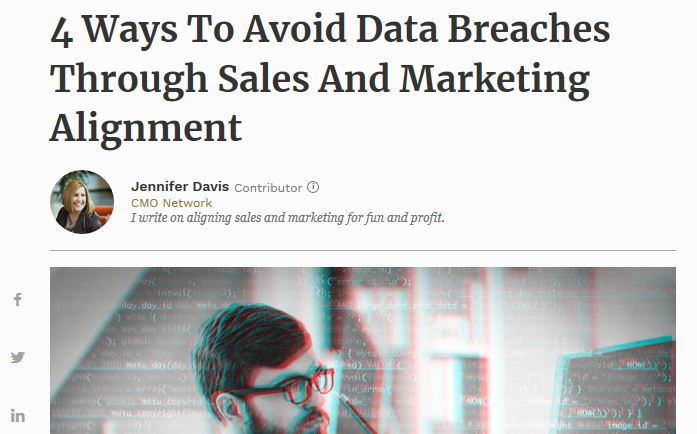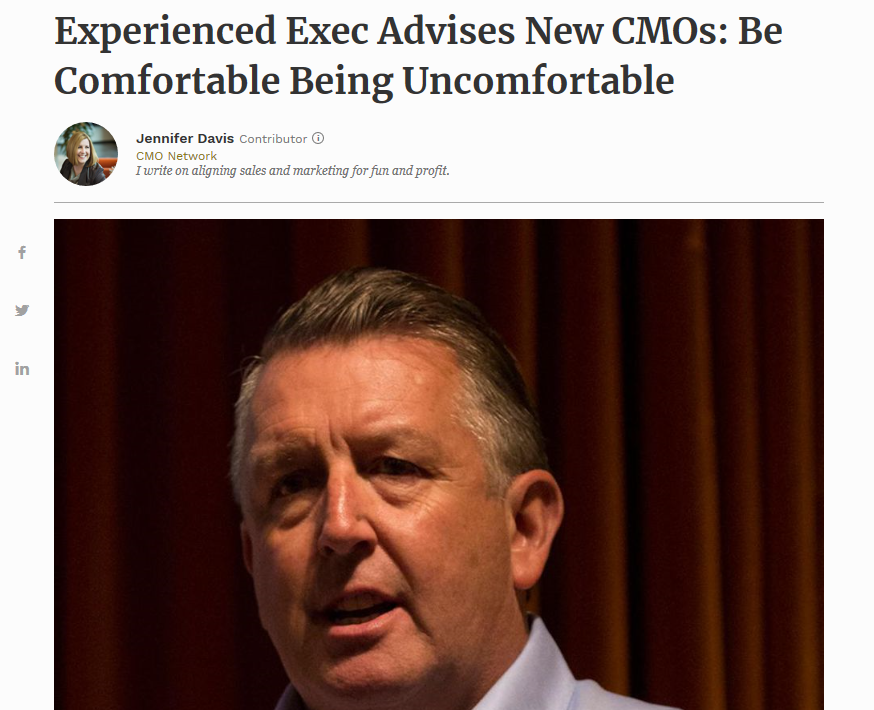In my latest Forbes article, I interviewed Martyn Etherington from Teradata. Read the full article here.
__________________________
Martyn Etherington knows what it takes to drive change from the office of the CMO and has plenty of lessons for new chief marketing officers. In fact, he himself is practicing being new. Six short months ago he joined Teradata, a data analytics company, drawing upon his extensive executive marketing experiences at IBM (Sequent Computer Systems), Danaher (Tektronix), Mitel Networks, and Cisco Systems
Being new on the executive team, the need to align sales and marketing, a perennial priority, is even more sharply in focus. “Sales and marketing can be like the Montagues and Capulets from Shakespeare’s Romeo & Juliet,” Etherington joked. Even at the best run companies, alignment is hard won.
Etherington’s priorities these first few months he believes have set the foundation for the alignment that will be needed for transformation and hold some lessons for any CMO starting with a new company.
Goal Setting – tied to revenue and relationships
“The relationship between sales and marketing can also be, at times, as Winston Churchill described the U.S. and U.K., ‘two nations separated by a common language,’” he continued. “The key is shared language and goals,” not just perceptions. “We have one shared goal and that is ‘Growth’,” he summarized.
Etherington emphasizes that marketing should have intimacy with the business and that compensation should be tied to their sales peers’ goals. “I want them to know where are we regarding revenue, quarter to date, year to date,” he explains. “Are we growing quarter-over-quarter, year-over-year? Are we growing at or above market? Are we taking share? How does our collective sales funnel look?” For this, he looks at the size, shape, velocity, and quality of the overall pipeline and then asks “How can we help improve the funnel?” to keep the focus on action. As he has found “without these KPIs, without this insight and intimacy of our business, we are stumbling in the dark.”
Every organization would like to get better at attribution, but Etherington is “less concerned with perfect attribution, or optics. I would much rather spend time determining our impact on the funnel and top-line growth,” he said. It starts and ends with setting good Key Performance Indicators (KPIs) and a desire to “do good, not just look good.”
“Other than my boss, my number one priority was the partnership with my sales peer Eric Tom, our chief revenue officer,” Etherington offers. And those relationships extend through the sales organization and across between leaders in sales and marketing.
Etherington suggests that a good way to begin these conversations in your first few days on the job is to ask sales peers the following question: “If we were to nuke marketing, what would happen to our business?” This can solicit a range of responses, all useful for building a relationship and getting on the same page as to the priorities.
“Sometimes you get the answer ‘nothing would happen.’ Others attribute a portion of their sales results to marketing,” Etherington recalls. He has found that based on his B2B marketing experience, “organizations believe that, ideally, that they should get 20-30 percent of their funnel from marketing.” Some industries vary depending on the complexities of their offerings, sales cycle and whether they have a direct or indirect or blended go-to-market strategy, but no matter how much reliance there is on marketing to build the pipeline, it is important to create positive dependencies between marketing and sales that ties back to those shared goals and the relationships that are being fostered between the functions.
Teradata has an enterprise focus and sells direct. The sales are consultative and high touch. In this model, it may be more simple to track attribution to marketing than other go-to-market models, but it still requires vigilance and a focus on the right things. “Transparency is key,” he adds. “You need operational rigor around your own metrics. They need to be real and they need to be metrics that you can manage versus just monitoring.” As I have also found in my career, marketing has lots of things they can measure, but not all things that are measurable are important or lead to action. “We are interested in conversion and ultimately conversion," he continued. "That is more important to us than vanity metrics like touch points. We want to work with our sales peers to drive growth.”
Culture – a mindset change supported by systems
“You can pontificate all you like about alignment, insight, impact and effectiveness, but you have to have a business perspective, an appetite for operational rigor and a culture of continuous improvement to affect change,” Etherington challenged. You have to operationalize the strategic plan, with the right structures and systems in place, to achieve it. He has worked for companies with exacting business operating systems, like Danahar, with red, yellow, and green dashboard indicators and he has taken the opportunity to apply best practices of lean to his team at Teradata for strategy deployment, KPIs, action plans, and “root cause countermeasure” approaches. “We implemented weekly stand-ups and have begun a standard monthly marketing operations review to make sure we are making progress and attaining our KPI planned metrics,” he explained.
Cultures are known to change slowly. “We are at the beginning of a journey,” Etherington said. “We have begun our transformation. We have our strategic objectives in place, aligned with our company goals. We have our KPIs defined and populated, we have supporting action plans and forums for us to inspect and improve.” It’s a start, but there is more to do. “We don’t have all the answers,” he continued. “How much can we say that we contribute to our business? With only our first monthly marketing operations review under our belt, I can say not as much as we ought to be. Now we know where we are, our jumping off point, we have only one way to go!”
Any experienced executive will tell you that change - at the scale of a business transformation and a redefinition of what marketing means to an organization overall - can test the patience of the leadership and the organization. It can lead to organizational fatigue, misalignment, or impatience to rush to answers when the problems are not yet fully understood. Etherington finds that the power to achieve results first begins with a willingness to see the problems, in blaring detail, and face them head-on.
“One of the biggest challenges when moving from activity-based marketing to outcome-based marketing is the transparency, accountability, and responsibilities that come with that approach,” he explains. “We are in the infancy of our marketing effectiveness journey and most of our KPIs are currently in red.” The ambitions of the organizations and the standards set by the team are not yet reflected in the reality of the business. “That is not a comfortable feeling for many people,” he observed. “We are all raised to covet the gold star or turn a red metric into the green.” Everyone wants to do well and wants to do well as quickly as possible.
“One philosophy ingrained in me from my time at Danaher was the notion of ‘living in the red.’ In monthly operations reviews, if your KPI was green, we did not talk about it. It’s good. It’s at plan. What we wanted to discuss was the red KPIs - the variances from plan.” Living in the red means to ask questions like:
- What is the cause of the miss?
- What are the corrective actions underway?
- Are we making progress against our goal?
- Are the specifics in the supporting action plans to ensure we are executing strongly towards the KPI?
- Are we stretching enough?
The focus needs to be constantly brought back into focus on the things that need attention, action, or course correction. “It could be many months before that KPI would go to green, but it forces you to think differently, adopt a growth mindset and be ok, although not comfortable, being in the red,” Etherington instructed. “The confidence comes as you use the tools and know that with applied discipline eventually, you will achieve sustainable results.” Etherington knows this from experience. “It works," he advocates. "It is proven and has been to a large part a major contributor to my success and some of the companies for which I have worked.” Leaders have to be comfortable being uncomfortable and help their organizations do the same.
Of course, there are a host of strategies and tactics within these organizing principles that the CMO and teams need to implement from the start to be successful in the new role and for years to come. Seeking out data to inform decisions, building a great team and structuring them for success, influencing and being influenced by customers, and building a culture of continuous improvement take judgment and time. Focusing on the shared goals, and the systems and mindsets required to achieve them, even if they are uncomfortable at first, is a great place to start for any new CMO leading an organization to green.



























